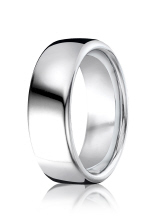
A member of the platinum group of metals, palladium is naturally white and has been rising in popularity with jewelers for decades. Palladium is whiter, 40% lighter, and 12% harder than platinum. When platinum was declared a strategic government resource during World War II, palladium was widely used as a substitute for rings and other jewelry. One of the most common metals found in white gold alloys, palladium is hypoallergenic, making it a practical substitute for those with nickel allergies. Over time, palladium will develop a patina similar to that of platinum jewelry.
PURITY
- Palladium alloys for jewelry manufacturing are pure, like platinum alloys used for the same. They are alloyed predominantly with other platinum group metals.
- The alloys consist of 95 percent palladium and are typically alloyed with ruthenium with trace amounts of other non-allergenic metals that contribute to hardness.
DURABILITY
- Like platinum, palladium wears better than white gold. Palladium jewelry a 15 percent greater wear resistance when compared to white gold.
- Palladium is comparable in weight to 14-karat gold, making it very comfortable to wear even larger pieces. 950 palladium has a specific gravity of 12.0. The specific gravity of most 14-karat white gold alloys is 12.7. With the specific gravities being almost the same, individual pieces of jewelry in 950 palladium and 14-karat white gold will weigh about the same.
- Palladium and other platinum group metals are hypoallergenic. Many 14-karat white gold alloys contain nickel, an element which commonly causes allergic reactions.
Sarraf.com offers a wide variety of palladium wedding bands and chains as well as one of our most striking items – a solitaire diamond ring in platinum that would make any engagement extra special.
See all of our platinum jewelry items at Sarraf.com and we think you’ll find the right one for the individual in you.
